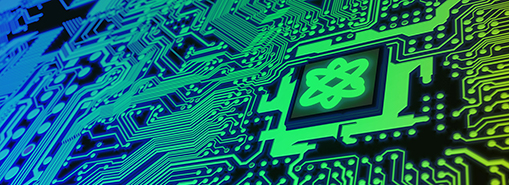
A team of FRIB scientists has received a three-year grant from the U.S. Department of Energy Office of Science (DOE-SC) to address challenges in nuclear physics via the development of more efficient and powerful quantum computing algorithms.
The work of Dean Lee, professor of physics at FRIB and in Michigan State University’s Department of Physics and Astronomy and head of the Theoretical Nuclear Science department at FRIB; Scott Bogner and Morten Hjorth-Jensen, both professors of physics at FRIB and in the Department of Physics and Astronomy; and Heiko Hergert, associate professor of physics at FRIB and in MSU’s Department of Physics and Astronomy (“Effective Field Theory and Renormalization Group Studies of Quantum Algorithms”) focuses on quantum information science with relevance to nuclear physics.
Nuclear physics research seeks to discover, explore, and understand all forms of nuclear matter that can exist in the universe. In their research, the group is exploring new connections between nuclear theory and quantum computing.
“Atoms are the building blocks of matter,” Lee said. “An atom has electrons on the outside and a nucleus on the inside. Our work at FRIB is all about what the nucleus is doing with its protons and neutrons.”
In studying the behavior of subatomic particles, “the rules of the game are much different.” Lee said. “At those very small length scales, the rules are governed by quantum mechanics, which is different from what we see in everyday life. We are big. The things around us are big. If we throw a ball, we know where it is, we know how fast it's going, we can see exactly what it's doing. In quantum mechanics, things are not so definite. Very small objects like protons and neutrons exist in a combination of different possibilities.”
The group’s research predicts the quantum mechanics of protons and neutrons in nuclei.
“The universe is actually a lot weirder than you might think,” said Lee. In some ways, their research is making sense of “the weird.”
Connecting nuclear theory with quantum computing
Quantum computing offers promising potential in addressing such challenges in nuclear physics. Lee and his colleagues already have done a good deal of work on these topics using classical computing. But quantum computing is another level altogether.
“A quantum computer is potentially very powerful,” he said. “But it's not quite as user-friendly as our classical computers. It’s a little bit less flexible. There's a lot of work now being put into making algorithms that will allow a quantum computer to do things that we can't do with classical computing.”
The group is looking to make quantum computing algorithms more practical, efficient, and powerful. Lee said the end goal is to provide an entirely new way to do what is done today on classical computers, such as predicting the structure of nuclei, and go beyond classical computing capabilities in simulating the dynamics of nuclear reactions.
Kathleen VanderVelde is a freelance writer.
Michigan State University (MSU) operates the Facility for Rare Isotope Beams (FRIB) as a user facility for the U.S. Department of Energy Office of Science (DOE-SC), supporting the mission of the DOE-SC Office of Nuclear Physics. User facility operation is supported by the DOE-SC Office of Nuclear Physics as one of 28 DOE-SC user facilities.
The U.S. Department of Energy Office of Science is the single largest supporter of basic research in the physical sciences in the United States and is working to address some of today’s most pressing challenges. For more information, visit energy.gov/science.
